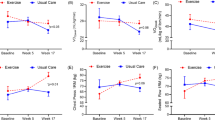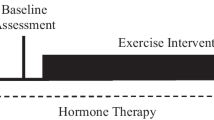Abstract
Purpose
To determine the start exercise prescription dose in metastatic castrate-resistant prostate cancer (mCRPC) patients receiving second-line hormone treatment and recommended phase II exercise prescription.
Methods
Patients were enrolled in a 3 + 3 dose escalation phase I trial of aerobic, resistance, and flexibility exercises to evaluate dose-limiting tolerance and safety. Tolerance was defined as Borg score ≤ 16 and safety (pain) as a visual analogue scale score (VAS) ≤ 3 and CTCAE grade < 2. Dose level 1 (escalation start dose) was set at 15 min. Aerobic training (50–80% HRmax warm-up and cooling-down; and 65–80% HRmax. core), 1 set with 8–10 repetitions (reps.) resistance training (50–60% 1-RM, 8 exercises), and 1 set (30s) with 2 reps flexibility training (5 exercises). The prescription dose escalation was designed in four levels (from dose −1 to 3), with a dose escalation in volume and intensity of the exercises.
Results
Nine patients were included in two dosing cohorts and were under active treatment (n = 4 abiraterone acetate and n = 5 enzalutamide). Dose limiting safety concerns were observed in 2 out of 3 patients in dose level 2 and 1 patient out of 6 in dose level 1 due to VAS > 3 during resistance training and/or flexibility training. No tolerance issues were observed in the two dosing cohorts. The optimal start exercise prescription dose was set at dose level 1 due to safety issues at dose level 2.
Conclusion
Our findings suggest that exercise is perceived tolerable in mCRPC patients receiving second-line hormone therapy. Caution is indicated on safety during performance of the exercises.

Similar content being viewed by others
Abbreviations
- ADT:
-
Androgen Deprivation Therapy
- ACSM:
-
American College of Sport Medicine
- BIA:
-
Bioelectrical Impedance Analysis
- BPI:
-
Brief Pain Inventory
- CPET:
-
Cardiopulmonary Exercise Test
- mCRPC:
-
Metastatic Castrate-resistant Prostate Cancer
- CTCAE:
-
Common Terminology Criteria for Adverse Events
- HRQoL:
-
Health-related Quality of Life
- IPAQ:
-
International Physical Activity Questionnaire
- KPS:
-
Karnofsky Performance Score
- MTP:
-
Maximum Tolerated Prescription
- PCa:
-
Prostate Cancer
- VAS:
-
Visual Analog Scale
References
Cornford P, Bellmunt J, Bolla M, Briers E, De Santis M, Gross T, Henry AM, Joniau S, Lam TB, Mason MD (2016) EAU-ESTRO-SIOG Guidelines on Prostate Cancer. Part II: treatment of relapsing, metastatic, and castration-resistant prostate cancer. Eur Urol 71(4):630–642. https://doi.org/10.1016/j.eururo.2016.08.002
Parker C, Gillessen S, Heidenreich A, Horwich A (2015) Cancer of the prostate: ESMO Clinical Practice Guidelines for diagnosis, treatment and follow-up. Ann Oncol 26(suppl 5):v69–v77. https://doi.org/10.1093/annonc/mdv222
Moreira RB, Debiasi M, Francini E, Nuzzo PV, De Velasco G, Maluf FC, Fay AP, Bellmunt J, Choueiri TK, Schutz FA (2017) Differential side effects profile in patients with mCRPC treated with abiraterone or enzalutamide: a meta-analysis of randomized controlled trials. Oncotarget 8(48):84572
Nguyen PL, Alibhai SM, Basaria S, D’Amico AV, Kantoff PW, Keating NL, Penson DF, Rosario DJ, Tombal B, Smith MR (2014) Adverse effects of androgen deprivation therapy and strategies to mitigate them. Eur Urol 67(5):825–836
Friedenreich CM, Wang Q, Neilson HK, Kopciuk KA, McGregor SE, Courneya KS (2016) Physical activity and survival after prostate cancer. Eur Urol 70(4):576–585. https://doi.org/10.1016/j.eururo.2015.12.032
Schmitz KH, Courneya KS, Matthews C, Demark-Wahnefried W, Galvao DA, Pinto BM, Irwin ML, Wolin KY, Segal RJ, Lucia A, Schneider CM, von Gruenigen VE, Schwartz AL (2010) American College of Sports Medicine roundtable on exercise guidelines for cancer survivors. Med Sci Sports Exerc 42(7):1409–1426. https://doi.org/10.1249/MSS.0b013e3181e0c112
Schmitz KH, Campbell AM, Stuiver MM, Pinto BM, Schwartz AL, Morris GS, Ligibel JA, Cheville A, Galvao DA, Alfano CM, Patel AV, Hue T, Gerber LH, Sallis R, Gusani NJ, Stout NL, Chan L, Flowers F, Doyle C, Helmrich S, Bain W, Sokolof J, Winters-Stone KM, Campbell KL, Matthews CE (2019) Exercise is medicine in oncology: engaging clinicians to help patients move through cancer. CA Cancer J Clin 69(6):468–484. https://doi.org/10.3322/caac.21579
Le Tourneau C, Lee JJ, Siu LL (2009) Dose escalation methods in phase I cancer clinical trials. JNCI 101(10):708–720
Borg GA (1982) Psychophysical bases of perceived exertion. Med Sci Sports Exerc 14(5):377–381
Galvao DA, Spry N, Denham J, Taaffe DR, Cormie P, Joseph D, Lamb DS, Chambers SK, Newton RU (2014) A multicentre year-long randomised controlled trial of exercise training targeting physical functioning in men with prostate cancer previously treated with androgen suppression and radiation from TROG 03.04 RADAR. Eur Urol 65(5):856–864. https://doi.org/10.1016/j.eururo.2013.09.041
Bourke L, Gilbert S, Hooper R, Steed LA, Joshi M, Catto JW, Saxton JM, Rosario DJ (2014) Lifestyle changes for improving disease-specific quality of life in sedentary men on long-term androgen-deprivation therapy for advanced prostate cancer: a randomised controlled trial. Eur Urol 65(5):865–872. https://doi.org/10.1016/j.eururo.2013.09.040
Cormie P, Newton RU, Spry N, Joseph D, Taaffe DR, Galvao DA (2013) Safety and efficacy of resistance exercise in prostate cancer patients with bone metastases. Prostate Cancer Prostatic Dis 16(4):328–335. https://doi.org/10.1038/pcan.2013.22
Galvao DA, Taaffe DR, Spry N, Cormie P, Joseph D, Chambers SK, Chee R, Peddle-McIntyre CJ, Hart NH, Baumann FT, Denham J, Baker M, Newton RU (2018) Exercise preserves physical function in prostate cancer patients with bone metastases. Med Sci Sports Exerc 50(3):393–399. https://doi.org/10.1249/mss.0000000000001454
Beaver WL, Wasserman K, Whipp BJ (1986) A new method for detecting anaerobic threshold by gas exchange. J Appl Physiol 60(6):2020–2027. https://doi.org/10.1152/jappl.1986.60.6.2020
Peus D, Newcomb N, Hofer S (2013) Appraisal of the Karnofsky performance status and proposal of a simple algorithmic system for its evaluation. BMC Med Inform Decis Mak 13:72. https://doi.org/10.1186/1472-6947-13-72
Lange-Maia BS, Newman AB, Strotmeyer ES, Harris TB, Caserotti P, Glynn NW (2015) Performance on fast- and usual-paced 400-m walk tests in older adults: are they comparable? Aging Clin Exp Res 27(3):309–314. https://doi.org/10.1007/s40520-014-0287-y
Hagstromer M, Oja P, Sjostrom M (2006) The International Physical Activity Questionnaire (IPAQ): a study of concurrent and construct validity. Public Health Nutr 9(6):755–762
Cleeland CS (6242s) The measurement of pain from metastatic bone disease: capturing the patient's experience. Clin Cancer Res 12(20):6236s–6242s. https://doi.org/10.1158/1078-0432.CCR-06-0988
Bosy-Westphal A, Schautz B, Later W, Kehayias J, Gallagher D, Müller M (2013) What makes a BIA equation unique? Validity of eight-electrode multifrequency BIA to estimate body composition in a healthy adult population. Eur J Clin Nutr 67:S14–S21
Sheill G, Guinan EM, Peat N, Hussey J (2018) Considerations for exercise prescription in patients with bone metastases: a comprehensive narrative review. PM R. https://doi.org/10.1016/j.pmrj.2018.02.006
Heywood R, McCarthy AL, Skinner TL (2017) Safety and feasibility of exercise interventions in patients with advanced cancer: a systematic review. Support Care Cancer 25(10):3031–3050. https://doi.org/10.1007/s00520-017-3827-0
Newton RU, Kenfield SA, Hart NH, Chan JM, Courneya KS, Catto J, Finn SP, Greenwood R, Hughes DC, Mucci L, Plymate SR, Praet SFE, Guinan EM, Van Blarigan EL, Casey O, Buzza M, Gledhill S, Zhang L, Galvao DA, Ryan CJ, Saad F (2018) Intense exercise for survival among men with metastatic castrate-resistant prostate cancer (INTERVAL-GAP4): a multicentre, randomised, controlled phase III study protocol. BMJ Open 8(5):e022899. https://doi.org/10.1136/bmjopen-2018-022899
Østergren P, Ragle A-M, Jakobsen H, Klausen TW, Vinther A, Sønksen J (2016) Group-based exercise in daily clinical practice to improve physical fitness in men with prostate cancer undergoing androgen deprivation therapy: study protocol. BMJ Open 6(6):e011460. https://doi.org/10.1136/bmjopen-2016-011460
Sheill G, Guinan E, Neill LO, Hevey D, Hussey J (2018) The views of patients with metastatic prostate cancer towards physical activity: a qualitative exploration. Support Care Cancer 26(6):1747–1754. https://doi.org/10.1007/s00520-017-4008-x
Foster C, Hector LL, Welsh R, Schrager M, Green MA, Snyder AC (1995) Effects of specific versus cross-training on running performance. Eur J Appl Physiol Occup Physiol 70(4):367–372
Dite W, Langford ZN, Cumming TB, Churilov L, Blennerhassett JM, Bernhardt J (2015) A Phase 1 exercise dose escalation study for stroke survivors with impaired walking. Int J Stroke 10(7):1051–1056. https://doi.org/10.1111/ijs.12548
Peiris C, Shields N, Kingsley M, Yeung J, Hau R, Taylor N (2017) Maximum tolerated dose of walking for community-dwelling people recovering from hip fracture: a dose-response trial. Arch Phys Med Rehabil 98(12):2533–2539. https://doi.org/10.1016/j.apmr.2017.03.027
Brondfield SC, Weinberg VK, Koepfgen KM, Molina A, Ryan CJ, Small EJ, Harzstark AL (2012) Effects of 6 months of abiraterone acetate (AA) on muscle and adipose mass in men with metastatic castration-resistant prostate cancer (mCRPC). J Clin Oncol 30(5_suppl):222–222
Cormie P, Galvao DA, Spry N, Joseph D, Taaffe DR, Newton RU (2014) Functional benefits are sustained after a program of supervised resistance exercise in cancer patients with bone metastases: longitudinal results of a pilot study. Support Care Cancer 22(6):1537–1548. https://doi.org/10.1007/s00520-013-2103-1
Wall BA, Galvao DA, Fatehee N, Taaffe DR, Spry N, Joseph D, Newton RU (2014) Maximal exercise testing of men with prostate cancer being treated with androgen deprivation therapy. Med Sci Sports Exerc 46(12):2210–2215. https://doi.org/10.1249/mss.0000000000000353
Acknowledgements
RB is supported by a PhD fellowship of The Research Foundation—Flanders (FWO).
Author information
Authors and Affiliations
Contributions
RB: conception and design, protocol development, data collection and analysis, manuscript writing. BD: conception and design, protocol development, data analysis, manuscript editing. NB: protocol development, data collection, manuscript editing. JVB: protocol development, manuscript editing. ML: conception and design, protocol development, data collection and analysis, manuscript editing. ER: protocol development, manuscript editing. VF: protocol development, manuscript editing. KD: protocol development, manuscript editing. AS: conception and design, protocol development, data collection and analysis, manuscript editing. NL: protocol development, manuscript editing. PO: conception and design, protocol development, data analysis, manuscript editing, project supervision.
Corresponding author
Ethics declarations
Conflict of interest
The authors declare that they have no conflict of interest with respect to the research, authorship and/or publication of this article.
Ethical approval
All procedures performed in studies involving human participants were in accordance with the ethical standards of the institutional and/or national research committee (Ethics Committee of the University Hospital of Ghent, number 2017/1099) and with the 1964 Helsinki declaration and its later amendments or comparable ethical standards.
Informed consent
Informed consent was obtained from all individual participants included in the study.
Additional information
Publisher's Note
Springer Nature remains neutral with regard to jurisdictional claims in published maps and institutional affiliations.
Electronic supplementary material
Below is the link to the electronic supplementary material.
Rights and permissions
About this article
Cite this article
Bultijnck, R., Deforche, B., Borrey, N. et al. Exercise prescription dose for castrate-resistant prostate cancer patients: a phase I prescription dose escalation trial. World J Urol 39, 357–364 (2021). https://doi.org/10.1007/s00345-020-03098-y
Received:
Accepted:
Published:
Issue Date:
DOI: https://doi.org/10.1007/s00345-020-03098-y




